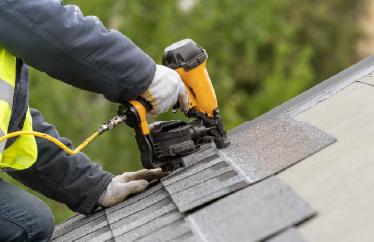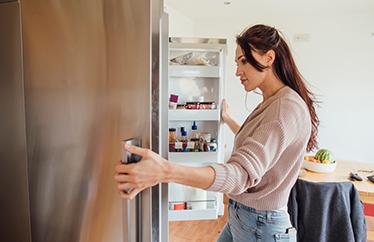Pet Proofing 101: How to Protect Your Stuff + Furry Friends
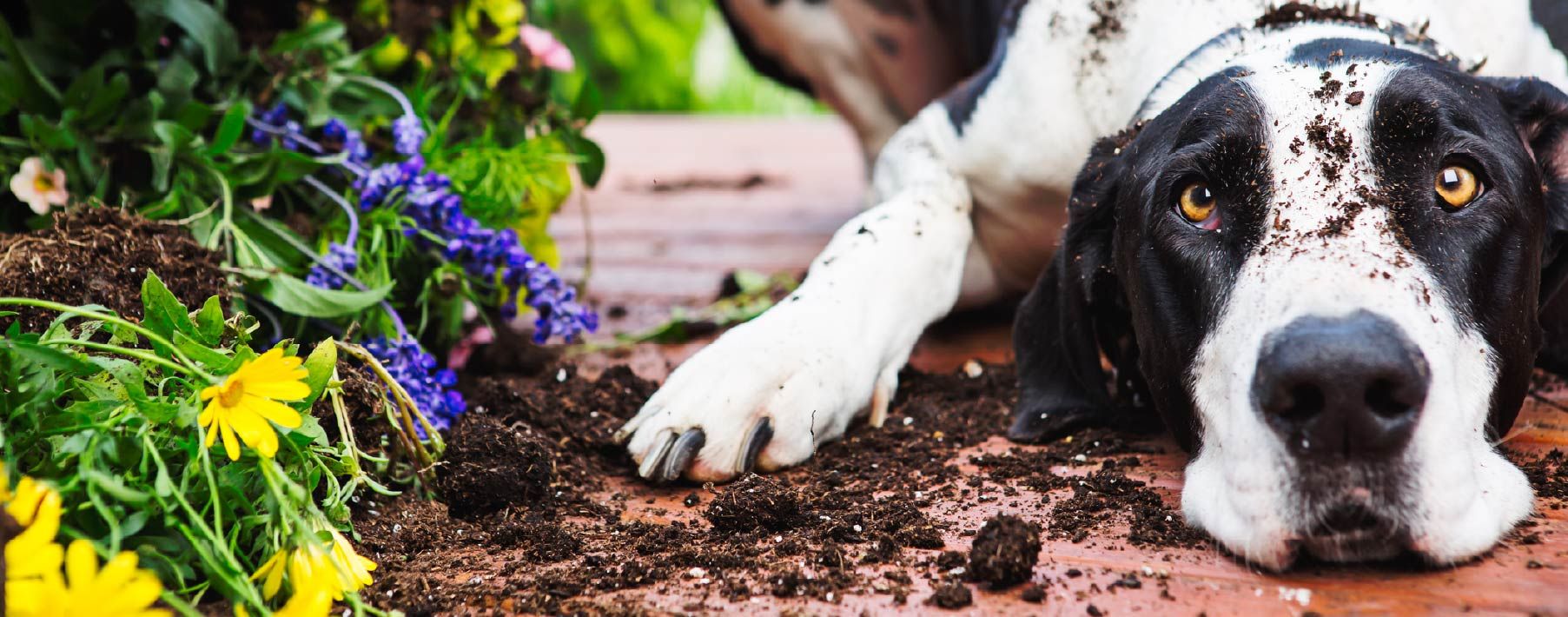
In The Secret Life of Pets, things go a little haywire as soon as the humans leave. Dogs escape out the window, art falls from the walls and plates crash to the floor. Though your pets may not throw a rager like Leonard the poodle did, chances are they’ve brought about their fair share of destruction in your home.
To keep your dog from destroying your pillows or your cat from scratching up the couch, you need to do some prep work. By pet-proofing your home, you can protect your four-legged friends and all your favorite belongings with ease. So if you’re haunted by the memories of your dog destroying your favorite piece of jewelry as a puppy, have no fear. Pet proofing (and jewelry insurance) are here to help.
Below, we break down how to pet proof every part of your home, from the bathroom to petscaping the backyard — looking for tips dedicated to your particular pet’s needs? We’ve got you covered with pet-proofing ideas for pets of all ages and energy levels. If you’re already a pet-proofing pro, take your home to the next level with these home upgrades for pets. And if you don't have pets but instead are looking to baby-proof your home, we've got you covered there as well.
How to pet proof your home
When you look at your home, you may not see many opportunities for pet injury or damage. But at your pet’s level, your home is a jungle gym of things to chew, scratch and ruin. For instance, a table leg can quickly become a chew toy or a brand-new rug could be mistaken for a litter box. To keep even your most high-energy pet safe and comfortable, pet proofing every room is a must (after you’ve used spring cleaning apps to deep clean your home, of course).
Living room
Though you may spend the most time cuddling and playing with your pet in the living room, your pet can still get into some mischief. After all, just one distracted moment can mean a damaged piece of furniture or an injured pet. Give yourself some peace of mind while your pet plays by implementing these pet-proofing steps.
- Add anti-scratch tape to the couch to discourage scratching
- Cover electrical cords to keep chewers away
- Cover HVAC vents
- Move or block exercise equipment to prevent injuries
- Place remote controls on a high shelf
- Pro tip: Any small decor or knick-knacks should be put away or moved to a high area
- Put down pee pads or water repellent carpeting for accidents
- Put kids’ toys away to avoid choking hazards

Kitchen
The kitchen is likely your pet’s favorite room in the house. The smells and occasional piece of dropped food is paradise for pups who never seem to feel full. But unfortunately, accidents do happen. From sharp utensils and extremely hot kitchen tech to pieces of food or wrappers that shouldn’t be ingested, being on high alert when your pet is in the kitchen is crucial. But when you’re busy cooking a meal, this can be easier said than done.
To help keep your pets safe and allow you to focus on the task at hand, make sure to properly pet proof your kitchen.
- Add a gate to keep counter surfers out of the kitchen
- Add lids to all trash and recycling bins
- Close the dishwasher when not in use
- Cover any small gaps between appliances and cabinets to keep cats out
- Keep cabinet doors closed
- Pro tip: Install childproof locks if your pet is inquisitive
- Never leave dangerous kitchen supplies out
- Put up a stove guard to keep your cat from jumping on a hot surface
- Store cleaning supplies and toxic food on a high shelf

Bathroom
Does your dog seem to follow you everywhere you go, including the bathroom? While it’s a sweet idea to think that they’re just protecting a member of their pack, their tailing tendencies means they have more opportunities to chew up your baseboards or steal the toilet paper roll. But with the following pet-proofing precautions, your best friend can follow you as you do your business or take a shower without you having to watch them the entire time.
- Always shut toilet lids
- Keep cleaning supplies locked away
- Keep hair accessories off the floor to prevent choking
- Move medicine to a high shelf where your pets can’t reach
- Put bitter spray on bathroom cabinet corners
- Pro tip: Most sprays can be used on fabric as well as hard surfaces
- Remove rugs until your pet has matured
- Take toilet paper off the roll and store in a cabinet

Bedroom
Pets change a lot about us. From improving our patience to making us more active, they allow us to grow as people. If you’re new to pet parenthood, you’ll quickly learn that pets also force you to become tidy. Otherwise, you risk losing your favorite t-shirt or pair of shoes to a mischievous pet. One of the biggest danger zones for clutter is the bedroom, where you may be used to leaving shoes out or throwing your dirty clothes on the floor.
To keep your favorite items from getting damaged by your pets — and keep them from eating something they shouldn’t — try out the following pet-proofing tips for your bedroom.
- Always close the closet door to keep your pets out
- Cover charging cables or charge devices on a high shelf
- Create a bed for your pet with blankets, toys and something that smells like you
- Ensure all plants are non-toxic
- Keep clothes, pillows and other items off the floor
- Make your bed each morning to discourage digging
- Pro tip: Tuck the corners of your bedding under the mattress to not tempt chewers
- Move lotions or lip balms to a high location

Garage
Your garage is used to store things you don’t want to keep inside your home, such as paint, tools, craft supplies and lawn equipment. Because of this, it isn’t the best place for your pet to be, especially without supervision. But if your pet loves the outdoors and enjoys hanging out while you work on your latest project, bringing them into the garage (or even a shed) can be done safely. In addition to keeping a close eye on them, make sure to follow these pet safety guidelines when letting them into these types of areas.
- Ensure proper ventilation when pets are in the garage
- Keep the garage door shut when not in use
- Properly store sharp objects such as nails, saw blades and screws
- Remove mouse and insect traps
- Remove or store chemicals, paint and other toxic substances
- Sweep the floor regularly to remove debris
- Pro tip: Set up a soft place for your pet to rest to avoid injuries from leftover debris

Yard
There’s nothing dogs love more than a day in the backyard, playing fetch and chasing the neighborhood squirrels. Some cats even love to explore the great outdoors as well, whether through an outdoor “catio” space or running free as an indoor/outdoor cat. To ensure your pet’s sacred outdoor time is as safe as possible, there are some things you can do to pet proof your yard.
- Block off access to electrical boxes, HVAC units and other home systems
- Don’t let pets outside when using weed or pest control chemicals
- Pro tip: Use eco-friendly weed and pest products to keep your pets safe
- Ensure all outdoor plants are non-toxic to pets
- Patch holes in the fence to keep pets from getting out
- Pick up pet waste consistently
- Put out food and water if your pet is outside for extended periods of time
- Remove lawn and gardening equipment when not in use
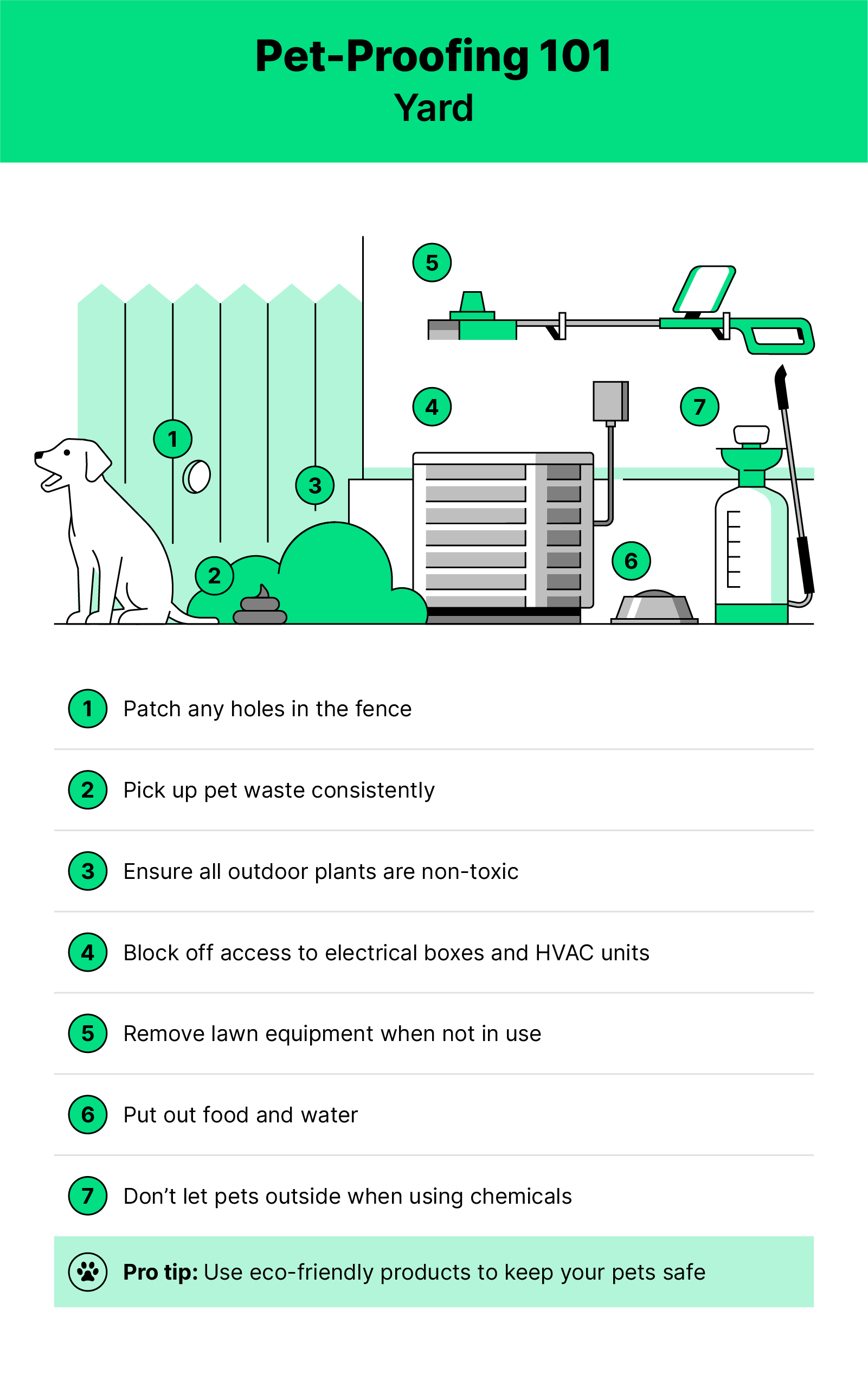
Ready to get started pet proofing your home? Download the following checklist to ensure you’ve covered all your bases.
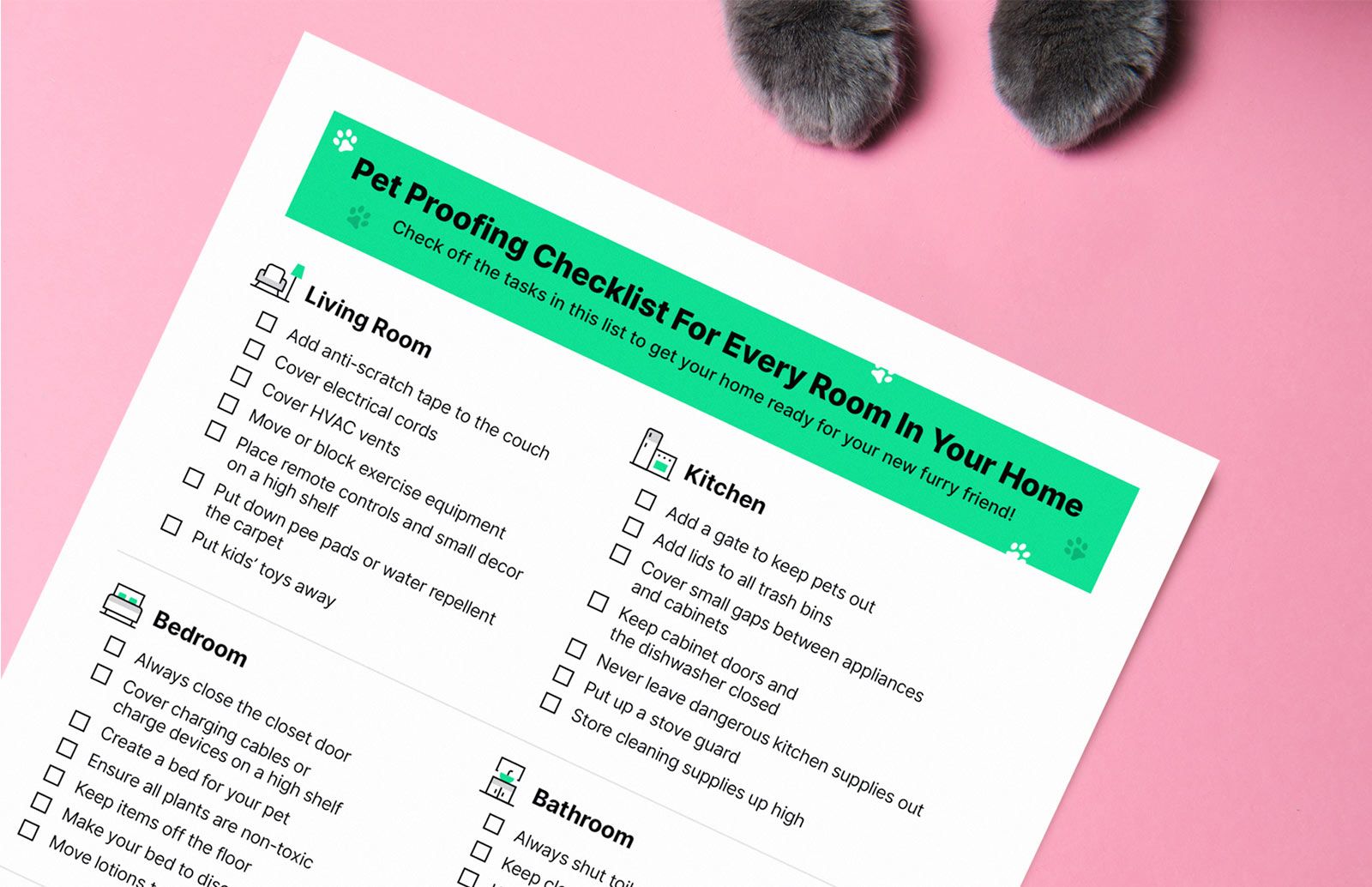
How to make your home their home
Making your pet comfortable in their new home is about more than just pet proofing. While the above tips can certainly help keep your pet safe, you also need to focus on their comfort and happiness. Whether you own a senior pet or just adopted an energetic puppy or kitten, check out the following tips to make your new best friend loves your home like you do.
Protecting playful puppies
Puppies. They are just as cute as they are destructive, chewing up your favorite items with ease and then cuddling with you to make up for it. While their puppy-dog eyes may have swayed you to forgive them time and time again, that doesn’t mean you forget. Next time, be prepared for the unexpected with the following suggestions.
- Invite other pets and people over to socialize and stimulate
- Keep treats on hand to reward good behavior
- Put away rugs and mats until potty training is complete
- Spray anti-chewing products on table legs, baseboards and anywhere else your pup shouldn’t be chewing
- Switch out toys every few weeks to prevent destructive behavior from boredom
Dodging doggy dangers
Older pooches require a lot less supervision than when they’re young. So while you won’t need to cover up as many cords or spray bite deterrent everywhere, there are still changes you can make around your home to keep man’s best friend more comfortable as they age.
- Add a ramp to couches, beds and stairs to ease aching joints
- Get them a new bed with more support
- Give CBD or other pain pills when needed
- Keep their exercise routine low-impact but consistent
- Provide plenty of teeth-cleaning treats
- Tape down the corners of rugs to avoid falls
Keeping out kooky kittens
If you got a cat because you heard they require less oversight than a dog, you aren’t wrong. But in their early years, cats can be just as rambunctious as dogs. From scratching up your leather couch to peeing on every rug in sight, kittens need to be trained and loved like you would any other animal. To keep your new little friend healthy and content, make sure to do the following.
- Empty their litter box regularly to keep them happy
- Install window screens if you open the windows regularly
- Keep toilet lids closed to prevent accidental drowning
- Pick up any small objects from the floor or counter and put in storage
- Prevent your kitten from napping in unsafe areas
- Pro tip: While kittens love small spaces, they can get stuck easily, so covering up gaps in furniture or appliances is key
- Provide plenty of toys and places to climb
- Remove all toxic plants from your home (yes, even those on a high shelf)
Calming curious cats
As they age, you may find yourself needing to watch your cat less and less. Cats tend to become more independent and self-sufficient over time, meaning your only real responsibility will be feeding them, cleaning out their litter box and giving them the occasional scratch behind the ears. But if you sense your older tabby is getting bored, or you just want to help them transition to old age with ease, the following tips can help you do just that.
- Buy an extra-soft bed for them to rest in
- Get a litter box with lower entry points
- Help them get up and down from high places to protect their joints
- Help them stay groomed with regular brushing and nail trims
- Keep note of any shift in your cat’s behavior
- Provide plenty of catnip and toys

Post-destruction decision: DIY or pro?
Even with every pet-proofing precaution taken, accidents happen. So if you find yourself with a stained carpet, a hole in the wall or a scratched up baseboard, you may be wondering how to go about fixing it. You could take the DIY route, but sometimes that can lead to more issues (and money) than if you just paid a professional to do it in the first place. Stumped on how to fix your new pet's destruction? Refer to the flowchart below to make the right decision. Or, if you have a policy with Hippo, you can just call the experts at our Hippo Home Care service to get the job done.

A happy pet is a happy home
The best way to keep your pets from destroying your stuff is to keep them happy. This means plenty of walks, playtime, toys and cuddles. The extra activity will help keep your pet occupied and direct all that energy to positive experiences, growing your bond and keeping your home safe at the same time. This, in tandem with pet proofing and proper homeowners insurance coverage, and you can rest easy knowing your home has protection from whatever comes your way.
Here at Hippo, we know just how important your pets are to you. They’re part of your family and should be treated as such. That’s why we’re here to answer any questions you have on how to get your home (and pets) the protection they deserve. Just give us a call.

